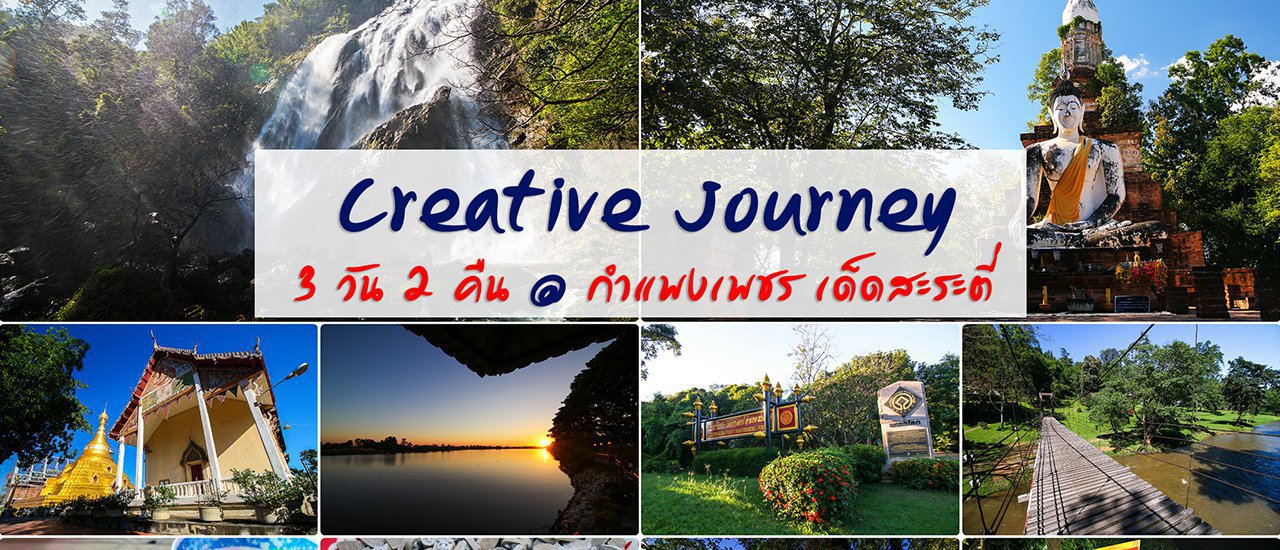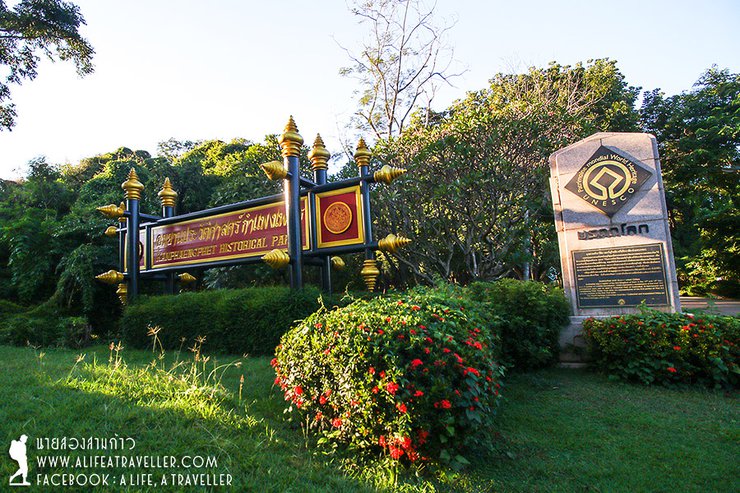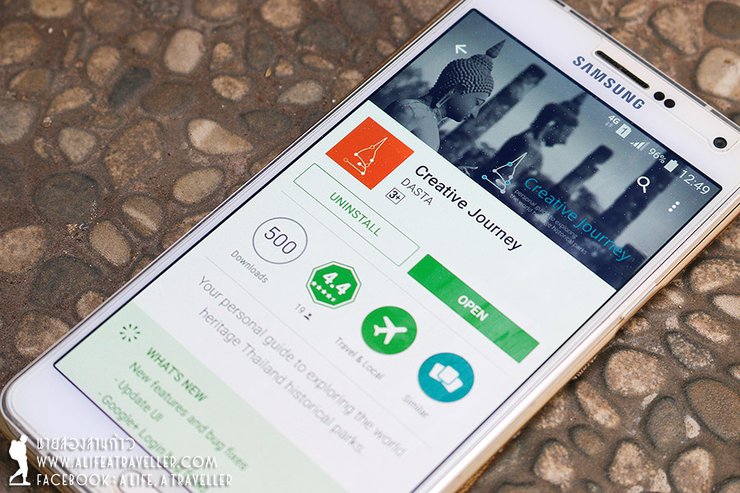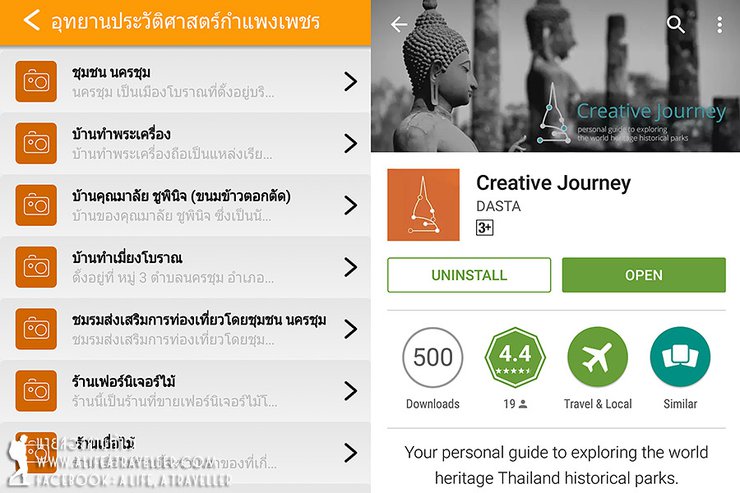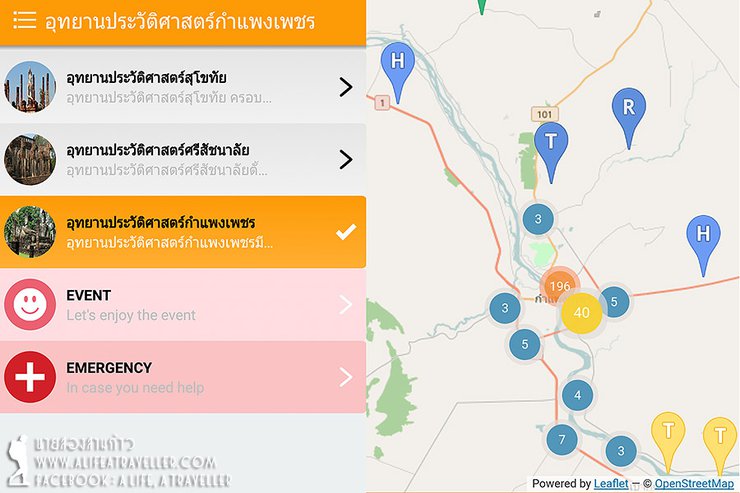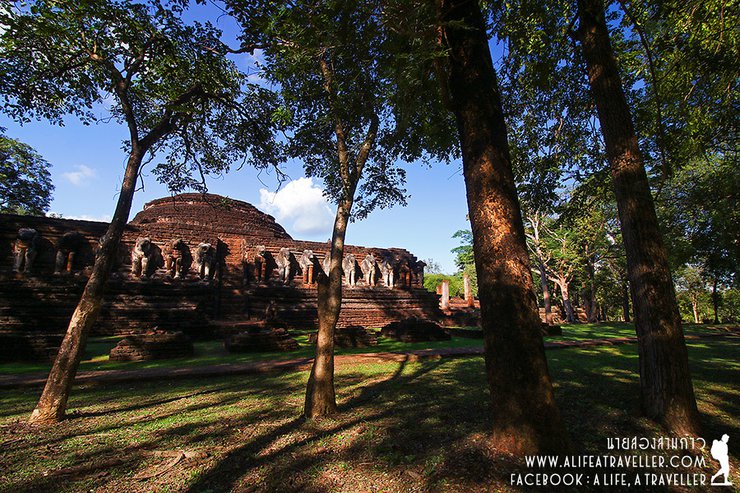DASTA, the acronym for the Tourism Authority of Thailand (TAT), is responsible for planning and promoting sustainable tourism development with a focus on local community participation. Currently, DASTA operates in six locations: Koh Chang (Trat), Loei, Nan Old Town, U Thong Old Town (Suphan Buri), Sukhothai-Si Satchanalai-Kamphaeng Phet Historical Park, and Pattaya.
This time, I was invited by the 4th Regional Office of the Sukhothai-Si Satchanalai-Kamphaeng Phet Historical Park to explore the highlights of Kamphaeng Phet. The three-day, two-night itinerary focused on Kamphaeng Phet, which was perfect for me as I had already visited Sukhothai and Si Satchanalai. (All three are UNESCO World Heritage Sites under the name Historic Town of Sukhothai and Associated Historic Towns).

The purpose of this trip was to test the Creative Journey application, developed by the Tourism Authority of Thailand (TAT), to facilitate tourism in the area and surrounding communities. The app provides information, navigation maps, contact numbers, opening hours, and details of tourist attractions, accommodation, restaurants, souvenir shops, etc. It also includes an Audio Guide mode that allows users to listen to audio descriptions of various locations without having to read them themselves.

Another interesting function is "Create Route," which allows users to design their own travel itineraries. By clicking "Create Route," users can write descriptions, add photos, and plan their entire trip from start to finish. They can then share their routes on various social media platforms, inspiring others to follow in their footsteps.


This is a fascinating app, and best of all, it's completely free. It's available for both iOS and Android. Just search for "Creative Journey" and give it a try. Feel free to leave comments and feedback.
Day One: History of Kamphaeng Phet Historical Park
The journey begins in Phitsanulok province. Upon arrival, I picked up a car key and set off. The route from Phitsanulok to Kamphaeng Phet is approximately 110 kilometers if driven directly. However, if one chooses to visit Sukhothai first before detouring to Kamphaeng Phet, the distance increases to around 150 kilometers.
After a brief detour to Sukhothai Historical Park, I arrived in Kamphaeng Phet in the late afternoon. The historical park is conveniently located within the city center, offering a tranquil and shaded environment. After paying the entrance fee, we received a map and drove along the designated route.

Notable temples worth visiting include Wat Chang Rob, Wat Phra Si Iriyabot, and Wat Phra Singh. These temples share architectural similarities with those found in the ancient city of Sukhothai, as this location served as a crucial frontier town for the Sukhothai Kingdom.



The most impressive temple I visited was Wat Phra Si Iriyabot. Behind the main building, there are four pavilions, each housing a Buddha statue in a different posture. On the front side, there are traces of a standing Buddha in the walking posture. The most complete statue is the standing Buddha on the back side, facing west. It makes me wonder how magnificent this temple must have been in the past.


The Kamphaeng Phet Historical Park also has another point of interest in the area of the ancient palace. The most interesting is Wat Phra Kaew, which is believed to be the temple of the royal palace. It has a large stupa in relatively good condition and a group of very beautiful Buddha statues.


The entrance to Wat Phra Kaew is also the location of the Kamphaeng Phet City Pillar Shrine. It is a good idea to stop by and pay respects.

Leaving the old town, you enter the modern city along the Ping River. My accommodation for the next two nights is on the other side of the river, called Mae Ping Mango Riverside Resort. The atmosphere is excellent, having just opened about a year ago. The rooms are large, clean, and comfortable, with private parking for each room. There is also a riverside restaurant available.




After a relaxing stay at the resort, head to the Walking Street along the Ping River for a bite to eat. Open every second and fourth Saturday of the month, this market offers a charming, laid-back atmosphere that complements the relaxed pace of Kamphaeng Phet.
A booth promoting community tourism by Kamphaeng Phet Municipality was present. They regularly introduce various activities for the public and tourists to learn. This time, they showcased the printing of terracotta amulets, considered a local treasure of Kamphaeng Phet.



After a satisfying meal, drowsiness sets in. Today's adventures have been fulfilling, and it's time for a well-deserved rest.
Day Two: A Community of Faith, Religion, Amulets, and Legends
If my home were in Kamphaeng Phet, I would gladly wake up to watch the sunrise over the Ping River every morning. The serene beauty of the dawn here would be a perfect way to start the day.


Breakfast at Mae Ping Mango Riverside Resort is a highlight. While there's no buffet, they offer a set breakfast menu with options like fried eggs, omelets, English breakfast, or rice porridge. It comes with a generous portion of seasonal fruits, toast, and juice, all for one person. Be prepared to be full!


Today's travel route is in Kamphaeng Phet city, starting at Nakhon Chum, an ancient community along the Ping River. Opening the Creative Journey app, I found an important temple there, Wat Phra Borommathat Chediyaram, which houses a golden Mon-style chedi.

A short drive from the accommodation leads to the majestic grand pagoda, visible from the moment you turn into the temple. This ancient temple dates back to the Sukhothai period, while the pagoda you see was renovated about a century ago, encasing the original three lotus bud-shaped pagodas.
The scale and grandeur of the buildings and structures clearly demonstrate the temple's significance as a major religious center in Kamphaeng Phet.




Ten o'clock sharp, I have an appointment to witness a fascinating activity at the Nakhon Chum Amulet Making Learning Center, located just a few hundred meters from Wat Phra Borommathat. Tourists know this place as Uncle Poey's House, a center for learning how to make clay amulets, a local wisdom of Kamphaeng Phet people.

Despite the passing of Uncle Sommai Payom, also known as Uncle Poy, in early 2016, the Payom family continues to uphold his legacy by sharing his knowledge of amulet making with future generations.
The meticulous process of creating clay amulets in Kamphaeng Phet, a renowned center for amulet production, involves several intricate steps. From preparing the clay and carving the molds to firing and decorating the amulets, each stage requires careful attention to detail. The popularity of replica amulets from Kamphaeng Phet stems from the city's rich history as a center for amulet production.




It is heartwarming to see that in addition to local youth learning the art of printing sacred texts, children and tourists from other regions also come to learn about the wisdom of the people of Nakhon Chum. Moreover, there are no fees involved, except for a token of appreciation that is optional. If you are interested in visiting or learning, please contact 086-932-4460 in advance.


After admiring the replica of the Buddha statue, I decided to search for authentic Kamphaeng Phet amulets. The most well-known is the Phra Sum Gor amulet from Thung Setthi in Nakhon Chum district.
Local residents report that ancient reliquaries are scattered across several temples in the Thung Setthi area, including various ancient pagodas in the middle of the rice fields (the pagodas remain, but the Buddha statues inside are gone). A visit is recommended.


Wandering through the alleys, I saw several ancient pagodas. Talking to the locals, I learned about Wat Pikul, another important source of "Phra Sum Gor" amulets. Upon arriving at the temple, I immediately approached the abbot and expressed my desire to see the "Phra Sum Gor" (haha...). He promptly retrieved them for me to admire. Those interested in acquiring one for worship are welcome to do so.

Approaching noon, hunger pangs set in. Arriving in Kamphaeng Phet, the most highly recommended dish was the Cha Kang Rao noodles. Checking an app, it revealed a famous original recipe restaurant in the city center on Ratchadamnoen Road. Upon arrival, we circled the block a few times due to the limited parking availability. The large crowd served as a testament to the restaurant's popularity.

The noodles arrived promptly after ordering, a dry bowl with a side of satay. The noodles were chewy and lived up to their reputation, while the overall flavor was well-balanced, albeit slightly sweet. As someone who enjoys spicy food, I added a generous amount of chili flakes. The dish was generously garnished with raw bean sprouts and julienned string beans, which were a welcome addition. The satay was equally delicious. At 30 baht for the noodles and 30 baht for the satay, the meal was a steal, even considering the challenge of finding parking.



In the afternoon, I drove to Tri-Trueng sub-district, about ten kilometers south of the city center, using the Phahonyothin Road.
Travelers come to Trai Trueng to follow the legend of Thao Saen Pom, a folktale about a man with a bumpy body (Thao Saen Pom disease) who received a blessing from a magical gong, ultimately becoming the ruler of the divine city, Thepnakorn, located near Trai Trueng, or the present-day Trai Trueng sub-district.
The small Taew Saen Pom Shrine, located on the banks of the Ping River, is revered by many. Every vehicle passing by honks in respect. The surrounding area is adorned with gongs offered as a form of prayer or fulfillment of vows, a practice rooted in local legend.


Adjacent to the Taew Saen Pom Shrine is Wat Wang Phra That, also known as Wat Taew Saen Pom. Within the temple grounds lies a significant historical monument, the largest bell-shaped stupa in Kamphaeng Phet. Its beauty is truly remarkable.


The Phra Ubosot enshrines Luang Pho Phet, a Buddha statue in the Mara-Vijaya posture with diamond legs crossed. The overall style is Chiang Saen, but the face is in the style of Kamphaeng Phet artists. There is no historical evidence, but it is estimated to be one of the oldest Buddha statues in Kamphaeng Phet.


A humorous anecdote about Luang Pho Phet is that if anyone makes an offering to him asking not to be drafted into the military, they are guaranteed not to miss it. That is, they are guaranteed to be drafted and have to enter the military. This is because Luang Pho loves soldiers the most. (Haha...)
On the way back to the city, along Phahonyothin Road in both directions, there is a souvenir market called the Banana Market or the Banana Market. There are processed snacks made from bananas, taro, sweet potatoes, etc. And if it is during the time when the banana is yielding a lot, there will be fresh bananas for sale, which are bright yellow on both sides of the road. You can stop by and buy them at your leisure.


This evening, we conclude with a serene view of the Ping River.

Day Three: Immerse Yourself in Nature, Western Forest
A riverside breakfast by the Ping River truly whets the appetite. After yesterday's rice porridge, today we opted for a Western-style breakfast before packing our belongings and checking out of Maeping Mango Riverside with fond memories.


Having experienced the historical sites on the first day and the community's way of life with religion on the second day, on the final day, I would like to explore another famous aspect of Kamphaeng Phet: its natural beauty.
This area is part of the Western Forest Complex, with three national parks: Mae Wong, Klong Lan, and Klong Wang Chao. However, with only one day, it is impossible to visit all of them. We choose to visit Klong Lan Waterfall and Klong Wang Chao Waterfall, both of which are only 60 kilometers from the city center. Although they are in different directions, with Klong Lan to the southwest and Klong Wang Chao to the west, there is a connecting road, making it easy to drive.
A mere hour's drive on a well-maintained road will take you to Khlong Lan National Park. After paying the entrance fee, you can drive straight to the parking lot, where the majestic waterfall awaits, sparing you the effort of a tiring hike.

The beginning of the winter season brings spectacular water levels to Khlong Lan. The abundant, crystal-clear water creates a refreshing mist that can soak you to the skin if you stand too close. While photography may be challenging, the invigorating experience is truly remarkable.




I spent nearly two hours immersing myself in the grandeur of Khlong Lan Waterfall before making my way back. On my return, I noticed a path leading up to the Khao Hua Khang viewpoint near the park entrance. Despite my limited time, I couldn't resist the allure of the climb. And it was well worth it. The view from above offered a breathtaking perspective of Khlong Lan Waterfall.

After a quick lunch nearby, we headed to Khlong Wang Chao National Park, following the GPS directions.
The Wang Chao Canal is a natural canal that serves as the boundary between Kamphaeng Phet and Tak provinces. At the tent camping area, there is a suspension bridge crossing the canal. The tourist service center side is Kamphaeng Phet, while the park accommodation side is Tak. Isn't that cool?


The most beautiful waterfall in the park is the Black Turtle Waterfall, but access requires a four-wheel drive vehicle and is best suited for overnight camping trips in the wilderness. For a more accessible experience, visitors can explore the Khlong Wang Chao Waterfall, located just a few hundred meters from the campground.
We parked the car and walked down to a large rock platform. A stream flowed from the forested mountains.

A short walk down the path will lead you to the waterfall. It is not very tall, but it is quite wide. To see the water cascading over the entire cliff face, you would need to visit during the peak of the rainy season when the water level is at its highest. However, during this time, the water takes on a rather ominous red color. Therefore, as you can see, it has a unique kind of beauty.


After leaving Khlong Wang Chao Waterfall, we immediately took a car to Kamphaeng Phet city, heading back to Phitsanulok Airport. It was a very enjoyable way to get to know Kamphaeng Phet Province. We were impressed by every aspect, including history, nature, religion, community life, and simplicity. It has its own unique charm.
At first glance, I fell in love. To say this is not wrong, is it?
Follow my travel adventures on another channel:
http://www.facebook.com/alifeatraveller
นายสองสามก้าว / A Life, A Traveller
Friday, October 4, 2024 3:08 PM

